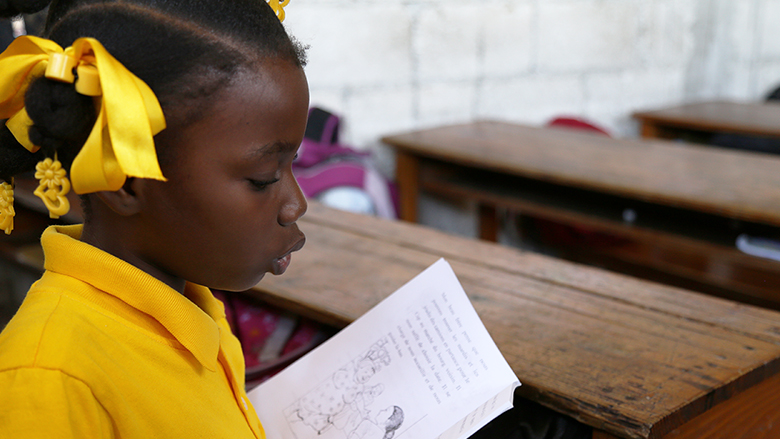Results
EFAII supported improvements in several key outcomes:
- The net enrollment rate increased from 50 to 60 percent in the early 2000s, before the Tuition Waiver Program (TWP), to an estimated 70 to 80 percent in 2012. The project also contributed to improving nonpublic school enrollment via the TWP (480,000 grants were disbursed under the EFAII project).
- 57 community-based schools were built in remote areas and continue to function, enrolling about 6,500 students per year between 2011 and 2018.
- A total of 457,897 students over the project’s lifetime benefited from the School Health and Nutrition program, encouraging attendance between 2011 and 2018.
- 3,570 teachers from rural communities were certified by the Pre-Service Teacher Training Program, and teacher training materials were distributed across the Ministry of Education and Professional Training (Ministère de l’Education et de la Fromation Professionelle) between 2011 and 2018.
- 26,718 students in 299 schools benefited from the scripted reading method M’Ap Li Net Ale between 2011 and 2018. An impact evaluation showed improvement in students’ foundational reading skills.
- 91 schools were rehabilitated following Hurricane Matthew in October 2016.
- A Quality Assurance System was developed by MENFP between 2016 and 2018, with technical assistance provided by the project, to establish school profiles based on agreed quality standards. This system laid the foundation of a framework to monitor the quality of service delivery at the school level.
Bank Group Contribution
The World Bank, through the International Development Association (IDA), provided US$70 million to Haiti’s Education for All Phase II program in 2011. In June 2014, additional financing in the amount of US$14.75 million from the Haiti Reconstruction Fund (HRF) was provided to cover a gap in funding the SHN program (School Health and Nutrition Program), and the project received additional financing in the amount of US$24.1 million in October 2014 from the Global Partnership for Education (financed by Australia, Belgium, Canada, Denmark, European Union, Finland, France, Germany, Ireland, Italy, Japan, Luxembourg, Netherlands, Norway, Republic of Korea, Spain, Sweden, Switzerland, United Arab Emirates, United Kingdom, United States of America) to help finance implementation of the MENFP’s transitional education plan and to scale up the project’s activities.
Partners
A sector group including major technical and financial partners in addition to the Bank — the Inter-American Development Bank, the European Union, the Caribbean Development Bank, the United States Agency for International Development, the United Nations Children’s Fund, and the United Nations Educational, Scientific, and Cultural Organization, among others — met periodically to help coordinate investments in the sector and offer technical support to the Ministry of Education.
Under EFAII, the Bank served an important role in mobilizing resources, including Canadian funds through the Catalytic Fund, the Caribbean Development Bank through parallel financing, and the Global Partnership for Education through a Recipient-Executed Trust Fund.
Beneficiares
Jessica Prudent, 11 years old, lives in Port-Au-Prince. She went to a school in Carrefour, one of the poorest neighborhoods of the capital. She benefited from the Tuition Waiver Program for six years, allowing her to attend school for free. In Haiti, parents have to pay on average US$130 each year to send their children to school, leaving more than 200,000 children who cannot pay out of school. On average, children start school two years late, as was the case for Jessica’s older sister. Her mom says, “The first one did not enter school early. She is 21 years old and in her final year of secondary school.” Jessica adds, “The Program EFAII helped me pursue my studies. If I did not benefit from it, I do not know where I would be at this time.”
Moving forward
One of the innovations under the project, the Quality Assurance System, is being taken forward in a new project, PEQH (Providing a Quality Education in Haiti). This program aims to make quality assurance the foundation of MENFP’s efforts. Its goals are (i) to ensure access to a quality primary education through a data and a result-oriented approach that measures schools’ progress, (ii) to develop improvement plansfor public schools, and (iii) to enable nonpublic schools to meet eligibility requirements for public financing. Lessons learned from EFAII were carefully integrated into the PEQH design, helping it to fast-track implementation and achieve results only a year and a half into implementation, despite challenging country circumstances.result-oriented approach that measures schools’ progress, (ii) to develop improvement plans for public schools, and (iii) to enable nonpublic schools to meet eligibility requirements for public financing. Lessons learned from EFAII were carefully integrated into the PEQH design, helping it to fast-track implementation and achieve results only a year and a half into implementation, despite challenging country circumstances.
